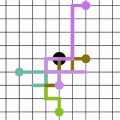Recent advances in graph-based learning approaches have demonstrated their effectiveness in modelling users' preferences and items' characteristics for Recommender Systems (RSS). Most of the data in RSS can be organized into graphs where various objects (e.g., users, items, and attributes) are explicitly or implicitly connected and influence each other via various relations. Such a graph-based organization brings benefits to exploiting potential properties in graph learning (e.g., random walk and network embedding) techniques to enrich the representations of the user and item nodes, which is an essential factor for successful recommendations. In this paper, we provide a comprehensive survey of Graph Learning-based Recommender Systems (GLRSs). Specifically, we start from a data-driven perspective to systematically categorize various graphs in GLRSs and analyze their characteristics. Then, we discuss the state-of-the-art frameworks with a focus on the graph learning module and how they address practical recommendation challenges such as scalability, fairness, diversity, explainability and so on. Finally, we share some potential research directions in this rapidly growing area.
翻译:以图表为基础的学习方法最近取得的进展表明,在模拟用户偏好和建议系统(RSS)的项目特征方面,它们取得了成效。RSS中的大多数数据可以组织成图表,其中各种对象(例如用户、项目和属性)之间有明示或隐含的联系,并通过各种关系相互影响。以图表为基础的组织为利用图表学习(例如随机行走和网络嵌入)技术的潜在属性提供了益处,以丰富用户和项目节点的表述方式,这是成功建议的一个关键因素。在本文件中,我们对基于图表的学习建议系统(GLRSs)进行了全面调查。具体地说,我们从数据驱动的角度开始,对GLRSs中的各种图表进行系统分类并分析其特征。然后,我们讨论以图表学习模块为重点的最新框架,以及这些框架如何解决诸如可扩展性、公平性、多样性、可解释性等切实可行的建议挑战。最后,我们在这个快速增长的领域分享一些潜在的研究方向。</s>



